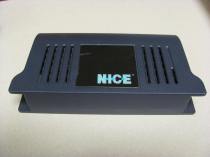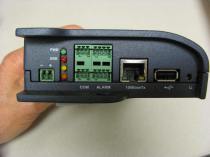I’m continually reminded of the fact that the smallest gap in one’s knowledge base can result in dead ends and delays that stretch a project’s timeline far longer than originally planned. This was certainly true in a recent video surveillance job that I did. I was not only installing new IP cameras in a location, but I was grandfathering in two existing analog cameras as well.
 We had three analog cameras in our Recreation Center, one of which was dead. The project scope included adding six IP cameras to the building (five in new locations and one to replace the dead analog camera) and using a conversion device called an encoder to translate coax-delivered analog data into digital IP-based data. There was no problem deploying the new IP cameras and getting them configured. During installation of the encoder (NICE Vision NVE1002) , however, I countered an unknown roadblock.
We had three analog cameras in our Recreation Center, one of which was dead. The project scope included adding six IP cameras to the building (five in new locations and one to replace the dead analog camera) and using a conversion device called an encoder to translate coax-delivered analog data into digital IP-based data. There was no problem deploying the new IP cameras and getting them configured. During installation of the encoder (NICE Vision NVE1002) , however, I countered an unknown roadblock.
I already was using an NVE1002 in another building so this was puzzling. When I brought up the live video display, I could see the six channels from the IP cameras, but not the two channels from the analog cameras. I verified that the encoder was on the network and the port I had it plugged into was open, because I could ping the device. Next I took the box over to the library where I had the other NVE1002 and swapped the two devices. No live video.
 I then took the Library encoder over to the Rec Center and plugged it into the network and the 2 coax cables. No live video. Just to sure, I asked my network administrator if he could see both devices on the network and he said he could. My next hunch was that the BNC connectors on the coax cables were not compatible with the inputs on the encoder so I studied up on that possibility.
I then took the Library encoder over to the Rec Center and plugged it into the network and the 2 coax cables. No live video. Just to sure, I asked my network administrator if he could see both devices on the network and he said he could. My next hunch was that the BNC connectors on the coax cables were not compatible with the inputs on the encoder so I studied up on that possibility.
Since I know nothing about coaxial cable and could not independently judge compatibility of the connectors, I went to a colleague with my quandry. He volunteered to bring the problem to the attention of some video experts and have them look at the problem the next time they came to campus. After testing with some diagnostic equipment they came to a remarkable (to me anyway) conclusion: the cameras were not powered on.
 I’m very familiar with Power-Over Ethernet (POE) equipment because, in fact, all of my IP cameras are POE devices. What I didn’t know until that moment is that coax can deliver power as well as data. The video monitor that was used to view the two analog cameras was also a DC power generator for them. The cameras also had no other was to receive power from an alternate source. That meant that I had to abandon the cameras altogether and purchase and install two new IP cameras (which I did not have in my possession at the time, of course).
I’m very familiar with Power-Over Ethernet (POE) equipment because, in fact, all of my IP cameras are POE devices. What I didn’t know until that moment is that coax can deliver power as well as data. The video monitor that was used to view the two analog cameras was also a DC power generator for them. The cameras also had no other was to receive power from an alternate source. That meant that I had to abandon the cameras altogether and purchase and install two new IP cameras (which I did not have in my possession at the time, of course).
This missing little gap in my knowledge turned the project from a 48-hour quickie into a 3-week head-scratcher. Luckily, the colleague for whom I was doing the work was much less affected and anxious about this than I was so there was no anger or blame on her part. In the end she was very happy with the results.
Anyone need an encoder?